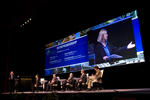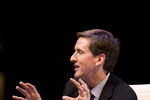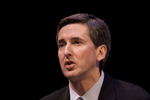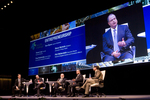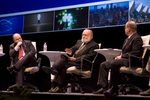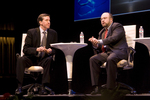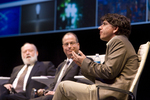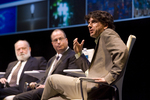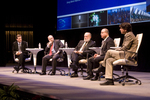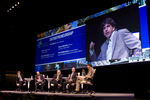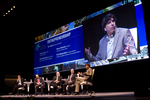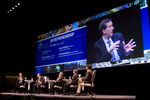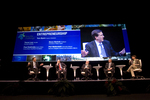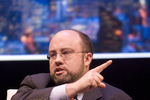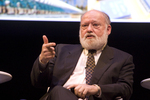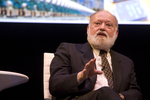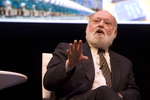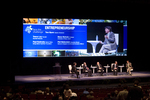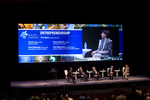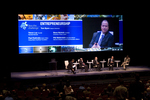- 2013 Research Triangle Park Summit
- 2013 Global Summit - London
- 2010 National Summit - Los Angeles
- 2010 Seattle Summit
- 2010 Chicago Summit
- 2010 Boston Summit
- 2010 Phoenix Summit
- 2010 Raleigh Summit
- 2009 National Summit - Durham
- Plenary Talk - Charles Vest
- Session I: Energy and the Environment
- Session II: Health
- Session III: Entrepreneurship
- Session IV: Security
- Session V: National Survey Findings
- Session VI: Understanding the Brain: Learning and Computation
- Session VII: Big Idea Panel
- Video/Essay Winners
- Speaker & Panelist Bios
- Poster Contest Winners
- Organizing Committee
- Summit Sponsors
- National Survey Results
- Grand Challenge Scholars Program
- Grand Challenge K12 Partners Program
Session III: Entrepreneurship
Session Photos
Session Summary
Session moderator: Tom Byers, professor, Stanford University
Panel discussion: Trevor Loy, founder, Flywheel Ventures; Steve Nichols, professor, University of Texas – Austin; Paul Kedrosky, senior fellow, Kauffman Foundation; Phil Weilerstein, executive director, National Collegiate Inventors and Inventors Alliance (NCIIA)
Throughout the Grand Challenges Summit, speakers, panelists and audience members said over and over again that meeting the 14 grand challenges is going to require more than engineering and technology. It’s also going to require driving forces in the form of public will, policy shifts and entrepreneurial activity.
In a free-wheeling discussion, the entrepreneurship panel brought a sense of enthusiasm, energy and risk-taking to the summit.
“At this point, there’s nothing left but entrepreneurship to solve the world’s problems,” said moderator Tom Byers. “We feel a sense of urgency. The 14 challenges are there. They are solvable. We should get going on them. Entrepreneurs have a wonderful trait—they’re always in a hurry.”
“We’ve talked about innovation; entrepreneurship is the action,” said Steve Nichols, professor at the University of Texas, Austin.
On a day when the Dow Jones industrial average fell almost 300 points, the panelists acknowledged that we live in uncertain times. But Paul Kedrosky, senior fellow at the Kauffman Foundation, pointed out that in the last 100 years, 1933 was the best time to create a bank. “There are reasons to think that some of the great opportunities of our lifetime are right here,” he said. “You are the ones—young science-centric types—who are going to find those opportunities and take advantage of them.”
The panelists would like to see engineers and entrepreneurs working more closely together, and they would also like to see entrepreneurship skills taught in engineering schools.
“Can you teach entrepreneurship?” asked Nichols. “Absolutely.”
The panelists shared some of their advice to those who have ideas for new products or services. Nichols said his favorite question is, “Who cares?” In other words, who wants this product or service and do they want it enough that they will be glad to pay for it? “If you can’t separate people from their money, you can’t succeed,” he said. This holds true, he reminded the audience, for non-profits as well as for-profit companies.
Kedrosky added another question: “Why now?” Many an entrepreneurial attempt has failed due to bad timing. (Quipped Phil Weilerstein, who directs the National Collegiate Inventors and Innovators Alliance (NCIIA), “Timing has an awful lot to do with the outcome of a rain dance.”)
Trevor Loy, founder of Flywheel Ventures, said it’s also important to ask, “Where’s the market opportunity? Where’s the cluster of people who care the most?” These days, the answer is as likely to be the other side of the world as next door, he said.
The panelists cautioned against trying to please venture capitalists. “Venture capitalists are never your customer,” Nichols said. “Focus on adding value to customers and separating them from their money.”
Kedrosky agreed, saying most venture capitalists don’t fund early-stage projects that don’t yet have a CEO.
Don’t isolate yourself, the panelists said. “Entrepreneurship is a team sport,” said Phil Weilerstein.
“It’s also a high contact sport,” added Nichols.
Stay flexible and be ready to adjust to changing conditions, Loy said. He pointed out that a technology designed to provide clean drinking water to soldiers overseas morphed into a gadget for recreational campers. “A technical solution originally developed to solve one problem became the solution to a problem that people hadn’t even thought of.”
Weilerstein said, “It needs to be a learning-by-doing process—learning from your failures and hopefully occasionally learning from your successes.”
“It’s all about failure,” Kedrosky said. “The likelihood of being successful as an entrepreneur is asymptotically low.” But entrepreneurs just keep trying, he said: “It’s like the ability to keep falling in love despite having your heart broken many times.”
Despite all that, Weilerstein encouraged young engineers and scientists to give entrepreneurship a try. “There is no better time to launch an entrepreneurial career than when you are young,” he said. “You have risks, but relative to the risks you’ll have twenty years later it doesn’t compare. We’ve got students who’ve created companies that employ hundreds of people and that save lives.”
Many of the panelists echoed earlier speakers in saying that young people today are interested in solving global problems.
“People look at society as continually decaying and I think quite the opposite is true,” Weilerstein said. “The interest I see in our programs [at NCIIA] in addressing social problems is something that gives me a great deal of hope.”
Summit TopicsSummit SpeakersSpeaker InterviewsSpeaker Topics



